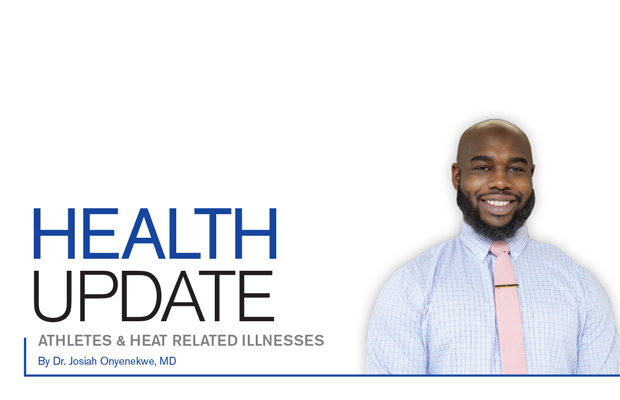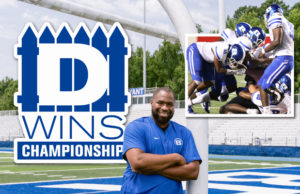Athletes & Heat Related Illnesses

As students head back to school and athletes get back in the game this fall, there are many health-related issues student athletes need to be on the lookout for. In Arkansas specifically, heat-related illnesses can be a major cause for concern among students spending a lot of time outside.
There are actually several different disease states and syndromes directly related to prolonged exposure to high temperatures. The symptoms can range from heat exhaustion, exercise-induced muscle cramps or collapse, heat edema, and life-threatening heatstroke. Those at the highest risk for these are athletes, outdoor laborers and military personnel.
Several factors can lead to an individual’s having an increased risk. Those can range from medications, environmental exposure, unknown or known medical conditions, and the inability to adapt to the current climate. This is usually due to an impaired ability of the body to cool itself based on the exposure, the body’s nourishment, and any restriction that can lead to an impaired cooling mechanism.
Some major risk factors are strenuous exercise in high temperatures or humidity; poor physical fitness; or excessive gear, clothing, or equipment. These heat-related illnesses are often found in high school students, with nearly 9,000 cases reported each year, and heat-related illnesses are among the top causes of death in athletes.
It is crucial to the safety of student athletes to understand the different conditions and their symptoms.
MILD CONDITIONS
Heat Edema
Heat edema typically presents with facial flushing or redness, and extremity swelling (usually in the lower extremity). Treatment consists of moving from the heat and elevating the extremity.
Heat Cramps
Symptoms of heat cramps include muscle spasms that occur mostly in the stomach, calves or thighs, normal body temperature, moist and cool skin (usually occurs after extended or intense physical activity). Treatment normally consists of moving from the heat, resting, leg elevation, stretching, massage, and oral electrolyte or fluid repletion.
Heat Rash
Symptoms of a heat rash include red papules/pustules or lesions on the neck, arms or legs, truck and groin (usually on skin covered by clothing). Treatment includes removing clothes and evaporative cooling (by drying the skin).
MODERATE CONDITIONS
(Treated in the Emergency Department)
Heat Syncope
Heat Syncope typically presents with lightheadedness, a syncopal episode or brief loss of consciousness (syncopal episodes usually occur immediately after strenuous activity). Treatment includes rest in the supine position, drinking fluids or IV rehydration, and elevation of the legs. Patients may seek treatment in an urgent care, Emergency Department or with their primary care physician for further evaluation.
Heat Exhaustion
Heat exhaustion is the most common heat-related illness, and can progress to heatstroke if not recognized early and treated. Symptoms include thirst, headache, fatigue, palpitations or tachycardia, weakness, syncope, nausea, vomiting, diarrhea, cold and clammy skin, slurred speech, stumbling, falling and incoordination. Body or core temperature reaches 101 to 104 degrees F, but the patient’s mentation is usually still intact; any alteration in mentation leads to a severe heat illness.
SEVERE CONDITIONS
(Treated in the Emergency Department)
Heat Stroke
Heat strokes are considered a medical emergency and require an extensive work-up. Symptoms include confusion, agitation, seizures, loss of consciousness, and delirium. Sometimes, individuals can have a lucid interval where they seem rational and okay before having a significant deterioration. Other symptoms include hypotension, tachycardia, heavy or fast breathing, and hot skin that may or may not be sweating. The patient’s temperature usually reaches above 105 degrees F. Treatment for heat strokes should include seeking treatment for heat exhaustion but also includes cold water or ice water immersion and possible hospital admission.
PREVENTION
The best way to treat these heat-related illnesses is to prevent them. Here are some important tips for preventing heat-related illnesses:
1. Hydrate adequately: drink fluids before practices as well as during
2. Wear loose-fitting and light-colored clothing; any heavy, saturated shirts should be changed often
3. Make sure players have adapted to the climate’s weather before spending extended time in the heat
4. Avoid activities during extreme temperatures or humidity
5. If avoiding activity outside is impossible, take these precautions:
a. Frequent water breaks
b. Scheduled rest and recovery rotations
c. Close monitoring, and using items such as wet bulb globe temperature meters with hand-held trainers to take into account temperature, humidity, and direct sunlight to make sure that environmental heat stress does not lead to heat-related illnesses. A wet bulb globe temperature meter reading of 160 should delay practice; anything over 180 means practice should be canceled.










0 comments